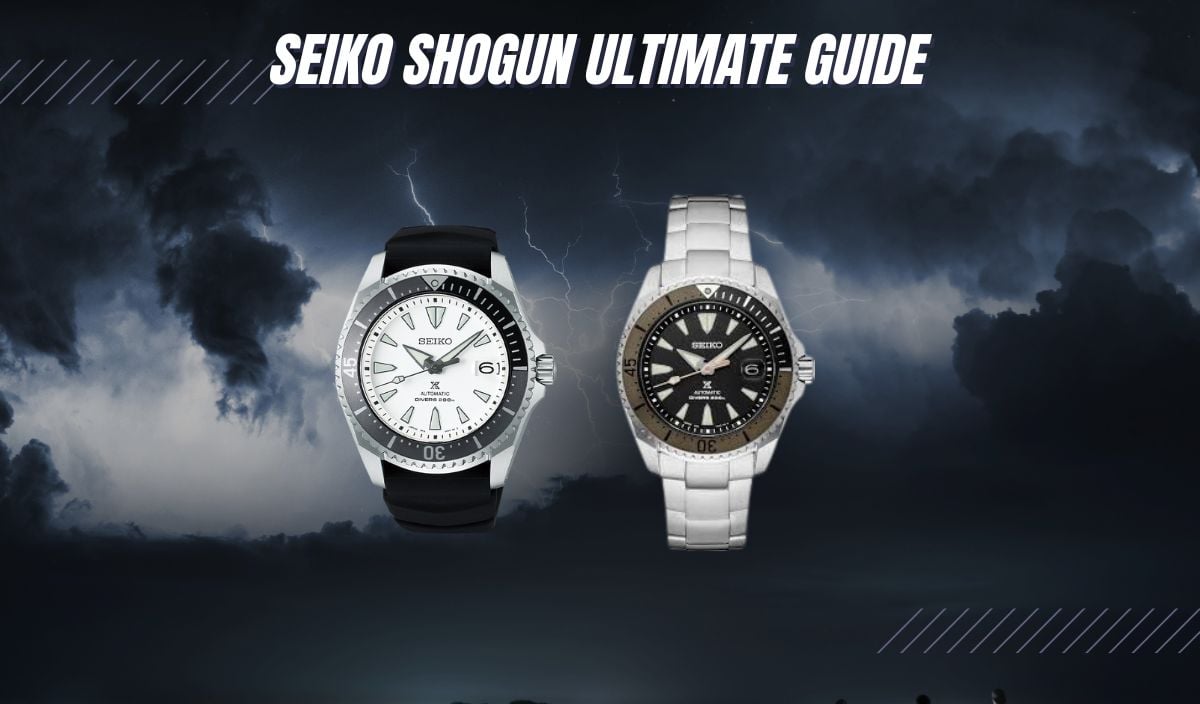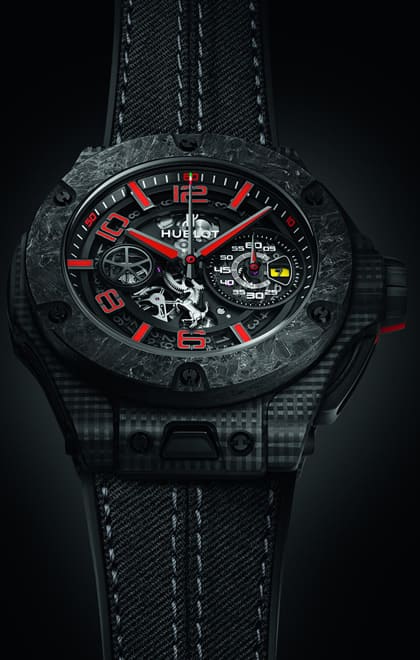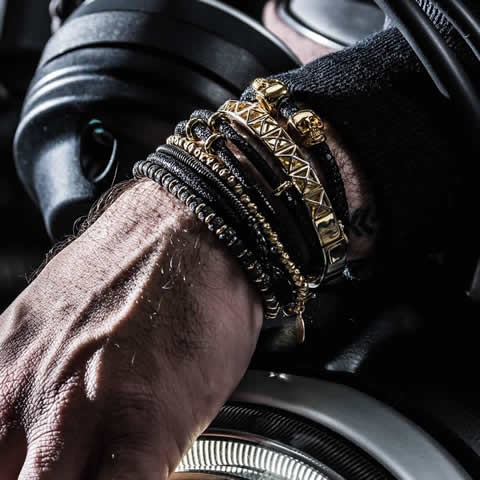
Ultimate Guide To The Seiko Shogun (EVERYTHING To Know!)
Monster, Turtle, Tuna, Sumo, Samurai, Arnie…all of these are popular nicknames attributed to Seiko watches and are a testament to just how much the Japanese Giant Watchmaker has a strong cultural presence. But Shogun? That’s one we haven’t heard of recently.
Left to obscurity and sometimes the domestic market, the Seiko Shogun has been walking in the shadow of other successful dive watches from the brand’s vast portfolio since its first appearance in 2008.
We all know that the aliases proliferating online for Seiko watches all have deeper meanings, and Shogun is not without significance either. Japanese for “military ruler”, the nickname Shogun was bestowed upon the robust diver by Seiko’s fanbase to echo the imposing presence and dominating spirit of the watch.
From the history and origin of the Seiko Shogun all the way to the iconic generations that followed its release, here is an ultimate guide to one of the most ultra-robust and accessible divers of all time.
About Seiko Dive Watches
Seiko is a brand that is respected for its commitment to producing some of the best entry-level divers in the market that has charmed collectors for decades. The story of Seiko’s diver’s line of watches can be traced to the 1960s with the Tokyo Olympics.
There was a need to produce a high-performing timepiece to help the Japanese watchmaker compete with the Swiss brands hence the launch of the first dive watch from Seiko, the 6217 (62MAS), in 1965. It doubled as the first Japanese dive watch ever with a 150-meter water resistance rating.
Before this launch, Seiko had introduced a series of pre-divers, such as a few in the Seiko Sportsmatic SilverWave collection, with 50 and 30-meter water resistance. The 62MAS, however, is recognized as the brand’s signature entry into the realm of true divers.
The first version had a small crown with reference 6217-8000 and a short production span of only 90 days. An improved version (Ref. 6217-8001) with a larger crown was released the same year.
The watch featured all the necessary dive watch elements, including luminous hands and markers, a bi-directional rotating bezel, domed plexiglass, a date window, and a low-beat automatic movement ticking at 18,000bph.
It quickly gained popularity and was a good competitor in the dive watch market until 1967, when the 6215-8000 came on board. It was the brand’s first 300-meter professional model with a Hardlex crystal and a screw-down crown.
A year later, the 6105 model, a hotly sought-after iteration, followed. The 6105-8110, or Captain Willard, is famously worn by Martin Sheen in “Apocalypse Now”. It introduced the cushion case shape, which appears to be square with rounded sides and can be seen in the SRP collection today.
Research and development continued as the years went by, and many iconic divers with a cult following were released. Seiko divers hold a special place in the hearts of many watch enthusiasts and continue to offer excellent performance and durability at accessible price points.
History & Origin of The Seiko “Shogun”
Immediately after its debut in 2008, the Seiko “Shogun”, officially the Ref. SBDC007, attained legendary status in the Horological sphere. The history of the iconic dive watch is themed around community involvement and a display of exceptional craftsmanship from Seiko.
The nickname was bestowed upon the divers’ from an adoring international public. It began with the watch’s description as a “full battle armor” with “crisp lines” that evoked imagery of a warrior under attack.
The trend continued, and like a pop out of the woodwork, Shogun was embraced by Seiko’s fanbase because of the imposing presence of the timepiece due to the armor-like elements of the case. The nickname quickly spread and became deeply ingrained in the watch’s identity, representing the dive watch’s comfort, character, value, and charm.
The Shogun is presented in a 44mm titanium case which, although lighter than steel, is highly capable of withstanding an impact without distortion.
Coming from the Seiko Prospex line, the watch is powered by the caliber 6R15 movement, which guarantees accurate timekeeping and boasts a 50-hour power reserve with hacking and manual winding functions.
The Story of the Seiko Shogun attests to the commitment and passion of a caring community. Its alluring design, combined with excellence, undoubtedly guaranteed it a spot in watchmaking history.
The deeper we uncover the Seiko Shogun, the more we face outstanding testaments of unique features and enduring appeal. With all these in perspective, there’s no argument that the Seiko Shogun is an iconic timepiece with a track record of excellence.
Seiko “Shogun” First Generation
The first generation of the Seiko Shogun was released in 2008. The SBDC007, along with its orange variant SBDC009 were the two dive watches to first appear in Seiko’s catalog. Let’s take a closer look at the SBDC007.
The Case & Bracelet
The case of the SBDC007 had large dimensions. It measured 44mm in diameter (without the crown) and was 13.3mm thick, with a lug-to-lug distance of 50.75mm. Titanium was used for both the case and the bracelet, making the watch lightweight and providing a high level of resistance to corrosion and outstanding durability.
The classic elements defining the Shogun’s distinctive feature were first evident in the case of the SBDC007, as it featured a muscular angularity with razor-sharp transitions.
The sharp dynamism of the watch can be noticed in crown protection, robust shoulders, angled inner lugs, deeply notched bezel, and flowing bevel along the circumference of the case that results in four flawless angles where the steeply angled lug descends.
The case is brushed on top while the sides are polished, and the screw-down crown is signed with a simple S. The screw-in case back is also polished and has a few specs engraved in it as well as the Seiko Divers Tsunami logo.
The titanium bracelet features a three-fold clasp with a secure lock, a diver’s extension, and a push-button release.
The Dial
The dial of the SBDC007 is presented in black with applied dot markers. The black surface is matte-finished, making the applied hour markers stand out all the more elegantly. At 12 o’clock, you will notice the usual inverted triangle or arrow with a line in the middle.
At 6 o’clock, there’s an italicized “Automatic” inscription, followed by “SCUBA” and then “200m” underneath it, keeping the symmetry quite balanced. Again the 6 and 9 o’clock markers are presented in sword-tip shapes that match the minute hand, while the hour hand is a reflection of the 12 o’clock marker.
There’s a neat date window at 3 o’clock and both hands and indices have been filled with Seiko’s proprietary Lumi Brite for excellent legibility in low-light conditions. The unidirectional bezel is executed in titanium and is a bit aggressive, with sharp sand-blasted knurling that gives it exceptional grip capabilities.
Movement
Under the hood of the SBDC007 is Seiko’s in-house 6R15 movement. The movement, which is just a step below most of the mainstream “high-beat” movements from Seiko, was produced in 2005. It is an upgrade from its predecessor, the 7S26, as it adds the hand winding and hacking mechanism to it.
It operates with 23 jewels and beats at a frequency of 21,600 vibrations per hour, keeping the second’s hand sweeping gracefully across the dial. It provides a power reserve of approximately 50 hours and is relatively accurate at +25/-15 seconds per day. The caliber 6R15 is a premium workforce and was made popular by Seiko’s SARB series, Seiko’s “Sumo”, “Alpinist”, and “62MAS Re-edition” watches.
Water Resistance
The SBDC007 is water resistant to 200 meters or 660 feet, making it a proper dive tool. This means it can be used for scuba diving and will comfortably keep accurate time when worn for other recreational water sports.
Other Models Of The First Generation
The other models of the first generation include the SBDC009 and SBDC029 and two limited editions, SPB057 and SPB099.
While the SBDC007 was popularly termed the “Black Shogun,” with its sleek and timeless design, the SBDC009 was referred to as the “Orange Shogun” because its vibrant color commanded a bold statement.
Moreover, due to Seiko’s commitment to continual innovation, loyalists eagerly awaited subsequent iterations. So, in 2015, Seiko ignited the passion of its dedicated fan base by introducing the Black Shogun Prospex (ref: SBDC029) to a zealous group of brand loyalists.
The SBDC029 was pretty much a relaunch of the SBDC007 with little changes on the dial. Compared to the SBDC007, the dial of the SBDC029 had different dial inscriptions. It featured the Prospex “X” logo in addition to the word “Automatic”, but this time, all capitalized.
Beneath that, you’ll see “DIVER’S 200m” neatly spelled out. Recall that the SBDC007 had an italicized “Automatic” inscription with the word “SCUBA” (not Diver’s) and then “200m” underneath it.
To cater to the desires of watch collectors, Seiko introduced limited editions of the Shogun designed exclusively for Thailand. Some of these editions were the Zimbe Shogun (ref: SPB057) and the Zimbe Red Shogun (ref: SPB099), released in 2017 and 2019, respectively.
Zimbe is a word coined from the Japanese name “Jinbe Zame”, meaning “whale shark”. The movement, case material, and layout of the dial are the same, but again, there are a few tweaks.
The dials have a graduating scheme, and the words ‘Automatic’ at 6 o’clock have been replaced with “Limited Edition”. The SPB057J and SPB099 also feature sapphire crystals with anti-reflective coating, as well as cyclops over the date window at 3 o’clock.
Seiko “Shogun” Second Generation
The second generation of the Seiko Shogun was launched in 2020 under the reference numbers SPB191J1 and SPB189J1. The mission of this launch was to replace its predecessor with enhanced reliability and functionality, so the main upgrade is more technical than visual.
That said, the Seiko Prospex Shogun SPB191J1 and SPB189J1 watches retain the core personality of the SBDC007 while incorporating some of the brand’s newest materials and technologies.
For dimensions, they measure 43.5mm in diameter (so still large yet able to sit comfortably), 51mm from lug to lug, and 13.3mm in thickness. The titanium case has the same angular lugs and strong shoulders with sharp crown protections for the screw-down crown.
The case is further finished with Seiko’s super-hard coating for additional robustness. The watches still deliver all the elements of the Shogun we have come to love, such as remarkable legibility and a 200-meter water resistance rating.
Both feature a sharp-toothed unidirectional bezel like that of their predecessors with a titanium insert. The bezel of the Shogun SPB191J1 is two-toned and presented in black and anthracite, while the SPB189J1 variant has a distinctive black and bronze layout.
Unlike the first Shogun generation, the Prospex Shogun SPB191J1 and SPB189J1 models have an upgraded sapphire crystal, which has a better scratch resistance than the Hardlex crystal found in the first generation.
The dials of the second generation also appear smoother and more rounded, resembling those on the Seiko Monster, and boast elegant triangle-shaped markers (no dots this time around) with more rounded hands.
We highlighted earlier that the main difference is more technical, which is evident in the movement mechanism. The second generation features the updated 6R35 caliber with 24 jewels and an impressive 70-hour power reserve. In contrast, the first generation uses 6R15 caliber with 23 jewels and a 50-hour power reserve.
While both movements offer hacking functionality and manual winding, the major improvement can be seen in the power reserve as the 6R35 provides 20 hours more than the 6R15.
Ultimately, the second-generation Shogun watches stand out in more ways than one. The various tweaks on the dial enhance legibility, while the improved power reserve makes it a better choice for watch enthusiasts.
Seiko “Shogun” vs Other Seiko Dive Watches
Seiko has been at the forefront of new technologies and designs since Kintarō Hattori released the brand’s first pocket watch, the Seikosha Timekeeper, in 1895.
The Seiko Shogun and other Seiko dive watches adhere to the brand’s high standards for the manufacturing of divers, garnering acclaim from professional divers all over the globe. However, the brand offers different types of diver’s watches at different price points.
Currently, there are over 120 models of divers in the Seiko Prospex collection, from mechanical watches to the solar-powered Prospex PADI Chronographs. Let’s see how the Seiko “Shogun” compares against other Seiko Dive Watches.
1. Quality
Even though Seiko has always focused on creating affordable dive watches, its watchmaking expertise and its proprietary technology have made it synonymous with high quality and expert craftsmanship.
There may be more style and functionality at almost every hundred-dollar increment when it comes to the watches in its catalog. But you can be sure that each one is made of high-quality raw materials, and the Shogun is no exception.
All Seiko divers undergo a series of stringent lab tests to prove quality, reliability, and durability before they are released to the general public. So the Shogun, like other dive watches, is designed to last long. The protective glass of the more recent release is made up of high-grade sapphire, while the older iterations feature Hardlex crystal.
Titanium, which is about 40% lighter than stainless steel but just as durable against impacts with similar technical and physical qualities, also gives the Shogun an edge over other dive watches from the brand.
Divers with nickel sensitivity will find the Shogun a preferable option because of the use of titanium. But, all in all, the quality is up to par with premium dive watches at the cutting edge of technology.
2. Legibility
Seiko dive watches are known for their straightforward, thoughtful, and highly legible design. Lume is always generously applied to the hands and indices with a high level of finishing on the hands and markers that not only play with the light for aesthetic purposes but also heighten the legibility of the watch.
The Shogun like many other dive watches has Seiko’s LumiBrite on the dial which glows brightly in the dark and will keep the timepiece highly legible at depths of 200 meters underwater. LumiBrite is a tremendously improved luminous paint that is completely free of radioactive elements and quickly absorbs light energy on exposure to it which it stores and emits in the dark.
Visibility is enhanced in every detail, and the bold markers and handset of the Shogun are a testament to this. Add that to an uncluttered dial, and you have a timepiece with no compromise or distracting ornamentation, a feature of every dive watch from the Seiko.
3. Movement
Seiko dive watches use three different movement variations. First, we have automatic or mechanical movements (such as the 6R35 in the Shogun) which are self-winding and work by harnessing the kinetic energy from the wearer’s natural movements.
Some other dive watches utilize quartz. This means they are powered by a battery that transfers an electric current via the quartz crystal, thus creating vibration and oscillation. The electric pulse from this oscillating movement then powers a small electric motor that turns the gears in the watch.
The last set of dive watches uses solar energy and works by converting light energy into electrical energy, which it stores in the rechargeable battery and ultimately uses to power the watch. The first generation of the Shogun used the 6R15 caliber, while the second generation is powered by the 6R35 caliber.
The latter is an evolution of the 6R15 movement and is found in many mid-range Prospex watches. Even though it’s not a very accurate movement, it is robust, reliable, easy to service, and offers great value for money. Quartz divers win in terms of accuracy and convenience.
Even though the 6R15 and 6R35 of the Shogun serve their purpose and count as a reliable power horses, the accuracy is poor. You will find them in dive watches that typically span the $300-$600 range, including famous dive watches like the ‘Sumo’ (Seiko SPB103J1) and the Seiko Prospex Recreation (Ref. SPB053J1).
4. Design
When compared with other dive watches from Seiko, the Shogun utilizes the same layout but adds something a little extra. The element of beauty in The Shogun can be found in the interplay of sharp angles and flat surfaces that interact beautifully with light and shadow to create a striking aesthetic effect.
When you look at the SPB189 & SPB191, you can see the standard divers watch feature with rounded sides and integrated lugs but the sharp lines and resilience of the Shogun are quite distinctive.
Seiko knows better than to change a proven recipe, so every feature in the Prospex collection that is loved can be seen here. I mean the overall design (which is close to that of a Samurai watch), the reasonable price, and of course, the overall performance.
So there are no major differences, only little tweaks here and there that make the watch appear more angular, creating a beautiful contrast, light on one side and shadow on the other to create an element of beauty.
At the core, the Shogun is just like other dive watches from Seiko with a polished and brushed case, screwed case back, a screw-down crown (both guaranteeing a 200m water resistance), and a highly legible dial.
5. Price
In terms of value for money, the Seiko Shogun holds its ground against other Seiko dive watches. When comparing prices, the Seiko Shogun is competitively priced within the dive watch market.
The Seiko Monster, for instance, starts at around $250. The Seiko Samurai is priced at about $525, while the Seiko Turtle hovers around the $400 mark. The Seiko Tuna series, known for its durability, can range in price from $300 to over $800, depending on the model and condition.
While these other dive watches have unique features and price points, the Seiko Shogun remains compelling.
The Seiko Shogun stands out on its own merits, but it is one of the most expensive entry-level dive watches from the Japanese Giant Watchmaker because titanium is used for the case and strap. Titanium watches are generally more expensive than stainless steel.
Even though the latter is abundant and readily available, it is more difficult to process and costs more to purchase and repair hence the higher price.
Whether you’re a sports enthusiast, an adventure seeker, or simply appreciate a high-quality dive watch, the Seiko Shogun offers a compelling package that will impress you; however, prepare to spend a bit more for it.
Should You Buy A Seiko “Shogun”?
The Shogun is a timepiece that commands instant attention. Depending on the vendor and model, you can get the Shogun anywhere from $1,200 to $3,500 for a brand-new model, and it’s no longer news that its titanium case sets it apart from other watches in the Seiko Prospex collection. Here are four reasons why you should consider adding Seiko Shogun to your collection.
- The value is just incredible.
The Shogun is a watch synonymous with excellent quality, fit, and finish. You will instantly recognize the high quality when you hold it in your hands. The watch is designed to be robust, reliable, and dependable.
- It is built using high-quality materials.
Titanium is one of the strongest materials out there, with a higher strength-to-density ratio when compared to stainless steel. The robustness of the case and bracelet of the Shogun will ensure longevity and durability, making it a watch you could wear every day for years without the slightest sign of getting worn out. From the onset, Seiko has never sacrificed durability in the making of any component, including the movement, which doesn’t change with the Shogun.
- Enhanced legibility in every detail.
From the hands to the hour markers and bezel, the high level of legibility can be seen in almost every detail. If you want a durable watch for underwater exploration, you need to be able to read it. Seiko knows this, and the Shogun will always remain one of the most legible divers. A generous application of Lumibrite on the hands, indexes, and bezel means that time can be read correctly from any angle and at any depth, adding to the watch’s appeal.
- 200 meters of water resistance.
The water resistance rating of the Shogun makes the dive watch reliable and suitable for the sport it is named for and for a great many underwater adventures. It can also be worn during sailing, surfing, and even fishing.
Concerning availability and price. The SPB189 & SPB191 are readily available and can be gotten from authorized dealers from Seiko worldwide. If you want a budget-friendly option, a pre-owned Shogun can be bought anywhere from $750 up, but you can purchase a new piece of the Shogun SPB189 here and Shogun SPB191 right here for $ and $1,350 respectively.
Conclusion
Let’s be honest. The Seiko Shogun isn’t for everyone. If you like the concept of a timepiece with an imposing presence, large dimensions, and premium features, then it’s a great option. However, the size and muscularity might not appeal to everyone, which is just fine.
Alternatives that can offer much of the Shogun’s features and charm can be found within the Seiko lineup. The Shogun, however, will forever remain one of Seiko’s emblematic dive watches beloved by devoted collectors, mostly because of its robustness and lightweight titanium case.
About Exquisite Timepieces
Established in 1998, Exquisite Timepieces is your one-stop shop for all things luxury watches! We are an authorized dealer for 60+ luxury watch brands including Omega, Hublot, Seiko, & Longines! We are proud to showcase one of the world’s largest pre-owned watch collections, including renowned brands like Rolex and Patek Philippe. Check out our brand new watch arrivals here and popular pre-owned listings here.








